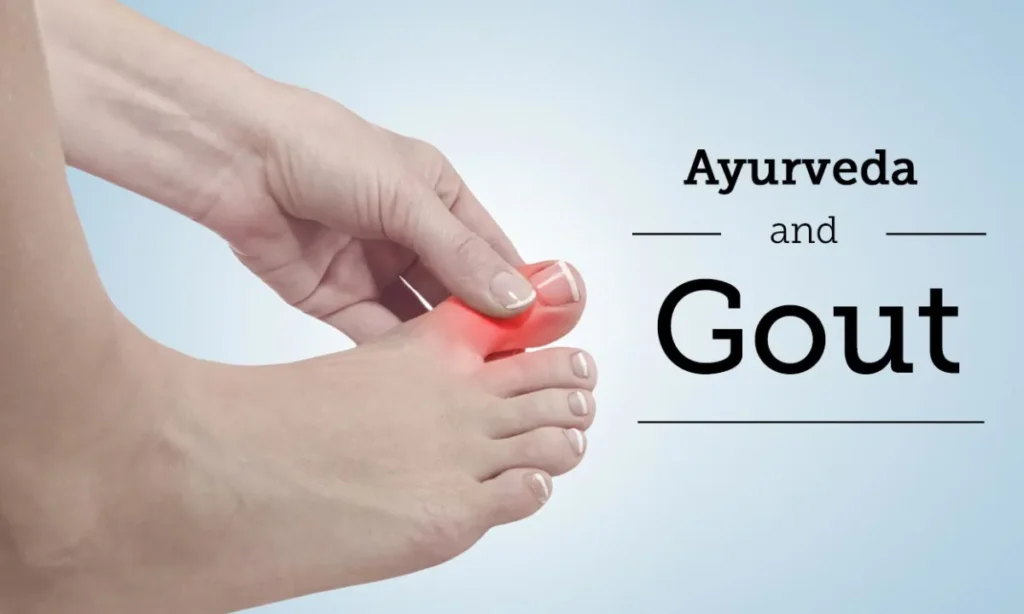Ayurvedic
Ayurvedic Treatment of Gout | Beneficial in Redness, Stiffness, Inflammation of the Joints
Ayurvedic Treatment of Gout:
Table of Contents
Introduction:
Gout is defined as the true crystal deposition disease which is mainly characterized by swelling and pain of the Ist metacarpophalangeal joint initially followed by other joints due to overproduction or under excretion of urate level. Also, it can be defined as the pathological reaction of joints to the presence of non-sodium urate monohydrate crystals. In India, Gout is rare in children and pre-menopausal females. In Studies, it was observed that males are more commonly affected than females.
An ayurvedic aspect of Gout:
In Ayurvedic terms, gout is known as ‘Vatarakta’ and is composed of two words – ‘Vata’ and ‘Rakta’. Also, it is known as Vata-balasa, Vatashra, and Adhya vata. Vata dosha, Pitta dosha, and Rakta dhatu are specially vitiated in the development of vatarakta.
Causes of Gout according to Ayurveda:
लवणाम्लकटुक्षारस्निग्धोष्णाजीर्णभोजनैः | क्लिन्नशुष्काम्बुजानूपमांसपिण्याकमूलकैः………………….कृत्स्नं सन्दूषयेद्रक्तं तज्ज्ञेयं वातशोणितम् | खुडं वातबलासाख्यमाढ्यवातं च नामभिः ||११||
- Excessive intake of sour, alkaline, pungent, oily, or unctuous foods.
- Intake of food in presence of heaviness in the abdomen or indigestion.
- Excess intake of aquatic animal’s meat and those animals living in marshy areas.
- Excess intake of black gram, radish, flat beans, dry meat, horse gram, curds, sugarcane, buttermilk.
- The regular habit of sleeping during daytime and awakening during nighttime.
- Frequently intake of food.
- Lack of physical exercise.
Symptoms of Gout according to Ayurveda:
स्वेदोऽत्यर्थं न वा कार्ष्ण्यं स्पर्शाज्ञत्वं क्षतेऽतिरुक् | सन्धिशैथिल्यमालस्यं सदनं पिडकोद्गमः ||१६||……………….कण्डूः सन्धिषु रुग्भूत्वा भूत्वा नश्यति चासकृत् | वैवर्ण्यं मण्डलोत्पत्तिर्वातासृक्पूर्वलक्षणम् ||१८||
- Sandi graham: Stiffness in the joints that lasts for more than 1 hour
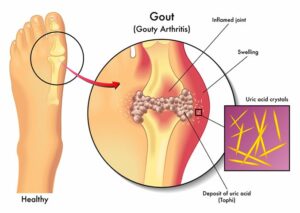
- Vaivarnya: Moderate discoloration of the skin
- Sandhi Shola: During flexion and extension, severe pain in the joints
- Sandhi Shotha: Edema or swelling of the joints
- Sparsha asahatva: Tenderness and pain of the affected part
- Daha: burning sensation
- Other Symptoms: Feeling of heaviness, numbness in knee, thighs, waist, shoulders, hands, and other joints of the body
- In some cases, circular skin lesions and the appearance of boils are there.
Pathophysiology of Gout according to Ayurveda:
When a person takes excessive above-mentioned foods, exposes to sedentary lifestyle activities, and is used to long-distance rides on animals like horses, camels, elephants, there is a disturbance in the functioning of the Vata dosha. On the other hand, blood gets vitiated by the excess consumption of amla, lavan, katu, and kshar guna foods.
Thus the vitiated rakta obstructed the passage of vayu and interferes with its functioning. The aggravated vata further undergoes vitiation and further contaminates rakta. And the rakta vitiated by vayu later burns the whole blood in the body. The contaminated blood leaves its place and gravitates towards the foot. Thus, this aggravated vata and rakta is called Vatarakta. This is said to be a serious symptom comprising of a disease called Vatarakta.
Types of Vatarakta according to Ayurveda:
The types of Vatarakta are mentioned below:
विशेषतः सिरायामशूलस्फुरणतोदनम् [१] |
शोथस्य कार्ष्ण्यं रौक्ष्यं च श्यावतावृद्धिहानयः ||२५||
- Vata pradhan vatarakta: When vata is severely vitiated and leads to symptoms like pricking pain, twitching, stiffness of body parts, and numbness.
श्वयथुर्भृशरुक् [२] तोदस्ताम्रश्चिमिचिमायते |
स्निग्धरूक्षैः शमं नैति कण्डूक्लेदान्वितोऽसृजि [३] ||२७||
- Rakta pradhan vatarakta: When rakta is severely vitiated and results in itching, swelling, severe pain, the copper color of the skin, and swelling.
विदाहो वेदना मूर्च्छा स्वेदस्तृष्णा मदो भ्रमः |
रागः पाकश्च भेदश्च शोषश्चोक्तानि पैत्तिके ||२८||
- Pitta pradhan vatarakta:When Pitta is severely vitiated in vatarakta and leads to symptoms like sweating, burning sensation, thirst, fainting, pain, swelling, and tenderness.
स्तैमित्यं गौरवं स्नेहः सुप्तिर्मन्दा च रुक् कफे |
हेतुलक्षणसंसर्गाद्विद्याद्द्वन्द्वत्रिदोषजम् ||२९||
- Kapha pradhan vatarakta: When kapha is vitiated and leads to symptoms like moistness, numbness, heaviness, and coldness.
Based on the location, Types of vatarakta will be:
उत्तानमथ गम्भीरं द्विविधं तत् प्रचक्षते |
त्वङ्मांसाश्रयमुत्तानं गम्भीरं त्वन्तराश्रयम् ||१९|
Uttana Vatarakta: It mainly afflicts the superficial tissues, i.e. skin and muscles, and the symptoms are also limited. The main signs and symptoms of uttana vatarakta are itching, pricking pain, throbbing sensation and the skin becoming red or coppery in color.
Gambhira Vatarakta: This involves blood and other deeper tissues like bone and joints and also the internal viscera. This looks like a joint pathology and its symptoms are more complicated. The major signs and symptoms of gambhira vatarakta include hardness, swelling, stiffness, twitching sensation in the joints, and blacking brown color of the skin.
If gout or vatarakta is located both in Uthana and Gambhira of the body, then the aggravated vata causing pain and burning sensation constantly move with high speed through the joints, bones, and bone marrow. And all the signs and symptoms described above in uthana and gambhira vatarakta are manifested.
Ayurvedic Treatment of Gout (Vata Rakta):
In Ayurveda, a detailed description of vatarakta is mentioned by Ayurvedic acharyas in different texts. Mainly it includes Shodhana and Shaman chitiksa. Different preparations and therapeutic modalities are mentioned by the Ayurvedic acharyas for shaman, shodana, and bahya chikitsa, which can effectively manage the symptoms and treat the disease. Panchakarma therapies like elakkizhi, pizhichil, abhyangam, snehapana, virechana, bsti, navarakizhi are very effective in managing the symptoms of vata rakta.
Raktamokshana in Vatarakta: The aggravated vata dosha and blood can obstruct the minute channels and give rise to various complications. Therefore, depending upon the strength of the patient and doshas involved, bloodletting is recommended for the management of vatarakta.
Ayurvedic Treatment of Gout from Deep Ayurveda:
In Ayurveda, several medicinal herbs are available that are rich in multiple qualities and are used from ancient times for the Ayurvedic treatment of Gout. Deep Ayurveda provides the best and 100% extract-based Ayurvedic medicines that work at the root cause, eliminate toxins from the body, improve the functioning of each organ, provide relief from associated symptoms of gout, and prevent a person from various complications. Below are the descriptions of each medicine that can be used as the Ayurvedic treatment of gout. We ensure that all the medicines are safe, free from chemicals, steroids, artificial flavoring agents, and alternatives.
Maharasnadi Kwath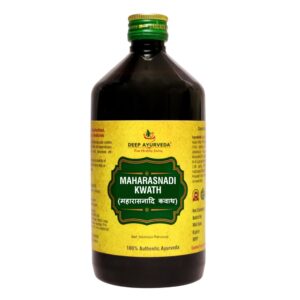 : Maharasnadi kwath acts as a dietary supplement and supports healthy joints function. This medicine is widely used as the Ayurvedic treatment of gout. It helps to balance the Vata dosha and soothes the inflammation in joints, relaxes the stiffness in muscles, and rejuvenates the surrounding tissues for providing relief from the symptoms of gout.
: Maharasnadi kwath acts as a dietary supplement and supports healthy joints function. This medicine is widely used as the Ayurvedic treatment of gout. It helps to balance the Vata dosha and soothes the inflammation in joints, relaxes the stiffness in muscles, and rejuvenates the surrounding tissues for providing relief from the symptoms of gout.
It has a broad spectrum of anti-rheumatic and anti-inflammatory properties and is beneficial in musculoskeletal related disorders. The composition of kwath helps to reduce the pain and inflammation and also improves the functional efficacy of the affected part.
Arthro Capsule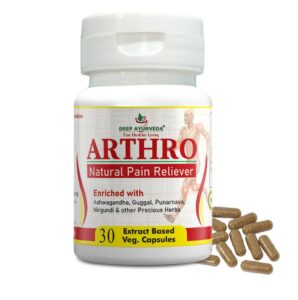 : Arthro capsule is one of the best choices in the Ayurvedic treatment of gout, thus it is rich in anti-inflammatory, anti-convulsing, anti-oxidant, and analgesic properties. Certain constituents present in arthro capsules inhibit the activity of an inflammatory protein that leads to a reduction in joint pain and inflammation associated with gout.
: Arthro capsule is one of the best choices in the Ayurvedic treatment of gout, thus it is rich in anti-inflammatory, anti-convulsing, anti-oxidant, and analgesic properties. Certain constituents present in arthro capsules inhibit the activity of an inflammatory protein that leads to a reduction in joint pain and inflammation associated with gout.
The ingredients like guggal and punarnava have vata balancing and mutral properties which gives relief from the symptoms of vatarakta.
Arthro Oil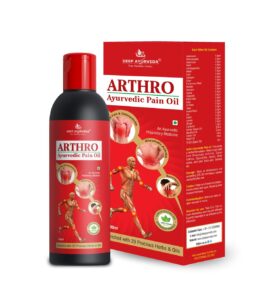 : Arthro oil is a composition of the best Ayurvedic herbs that are used since ancient times by the Ayurvedic Acharyas in the management of joint-related disorders and is the best choice for Ayurvedic treatment of gout as external use. Ingredients like bala, ati-bala, mustak, jatamansi, arandmool, vacha, devdaru are rich in analgesic and anti-inflammatory properties that help to purify the blood removes the toxins from the body, helps in reducing swelling, tenderness, redness, and helps in bringing balance to the production of uric acid in the body.
: Arthro oil is a composition of the best Ayurvedic herbs that are used since ancient times by the Ayurvedic Acharyas in the management of joint-related disorders and is the best choice for Ayurvedic treatment of gout as external use. Ingredients like bala, ati-bala, mustak, jatamansi, arandmool, vacha, devdaru are rich in analgesic and anti-inflammatory properties that help to purify the blood removes the toxins from the body, helps in reducing swelling, tenderness, redness, and helps in bringing balance to the production of uric acid in the body.
Livclear Capsule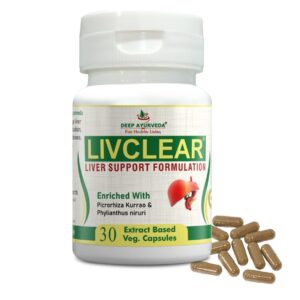 : Livclear capsule is very effective and is one of the best choices in the detoxification of the liver organ, helps in the blood purification, improves digestion, helps in balancing the aggravated doshas, and provides multiple health benefits to an individual.
: Livclear capsule is very effective and is one of the best choices in the detoxification of the liver organ, helps in the blood purification, improves digestion, helps in balancing the aggravated doshas, and provides multiple health benefits to an individual.
Thus, according to Ayurveda, a weak agni or digestive system can lead to the occurrence of multiple health issues, including joint-related disorders. The Livclear capsule will improve the functioning of the digestive system and prevents the formation of ama in the body.
Virog Tablet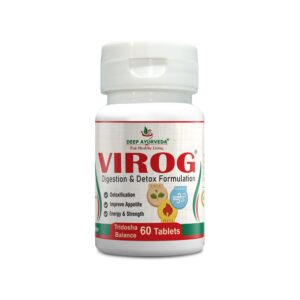 : The ingredients in the virog tablet effectively work in improving the functioning of the digestive system, preventing the formation of ama, and removing the toxins from the body. The tablets work as a Tridosha shamak, Rasayana, and are rich in anti-oxidant and anti-inflammatory properties.
: The ingredients in the virog tablet effectively work in improving the functioning of the digestive system, preventing the formation of ama, and removing the toxins from the body. The tablets work as a Tridosha shamak, Rasayana, and are rich in anti-oxidant and anti-inflammatory properties.
The active constituent of ingredients inhibits the activity of the inflammatory protein and helps in reducing pain and swelling associated with Vatarakta.
Diet and Lifestyle modifications for Gout:
A healthy diet and lifestyle activities play an important role in the prevention of joint-related disorders. Here are some diet and lifestyle modifications that must be followed along with the medicines for the management of gout and further prevention from upcoming complications.
- Needs to avoid sleep during the daytime.
- Intake of excess heavy, hot, pungent, saline, sour rich foods.
- Strictly avoid alcoholic beverages, especially beer.
- Avoid or decrease the intake of high-fructose drinks, which include sweetened juice and sugar-sweetened soda.
- Avoid or limit food that is high in purines such as organ meat, seafood, shellfish, red meat, some vegetables like cauliflower, mushrooms, etc.
- It is important to drink plenty of fluids throughout the day because fluids help flush uric acid from the body and prevent a person from occurring gout.
- Decrease high-fructose products like cereal, candies, and fast food.
- Extra weight added to the joints might suffer from a flare-up. It is very important to maintain weight by doing some exercises and consuming healthy food.
- There is some yoga asana that when practiced regularly not only help in reducing uric acid but prevents the deposition of crystals in the joints. These asanas are: Bhujangasana, Dhanurasana, Halasana, Pavan mukhtasana, Veerasana, etc.
For more detail on ‘Ayurvedic Treatment of Gout’, please visit our nearest clinic or if you want to consult with our Chief Ayurveda Consultant & Founder – Dr. Baldeep Kour then write with detailed history at info@deepayurveda.com
For regular health updates, please follow our Social Pages

